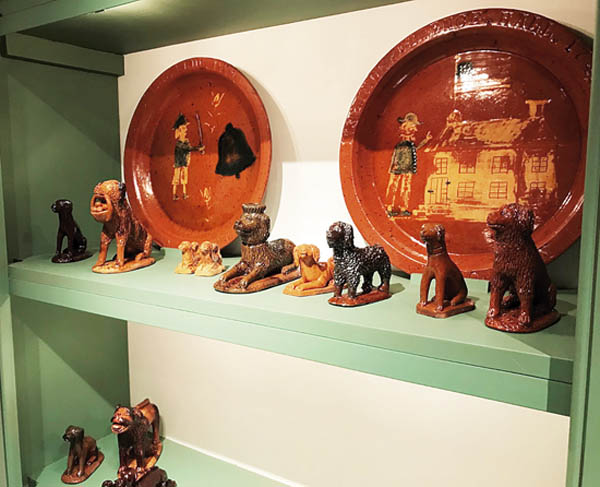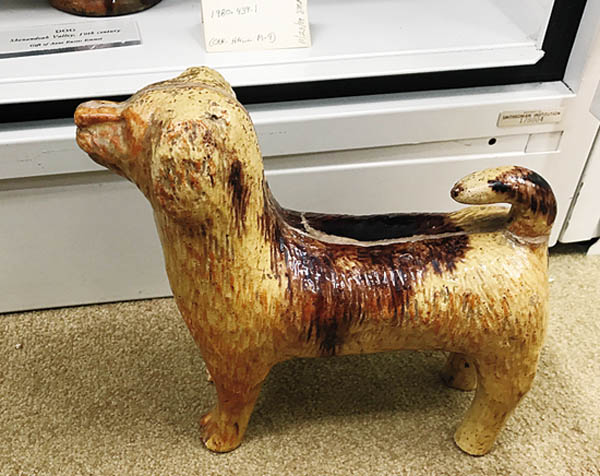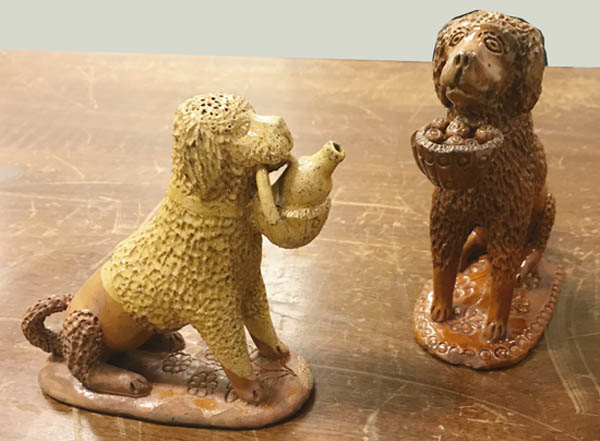A Look At 19th-Century Red Earthenware Figures Made In Pennsylvania
By Justin W. Thomas - August 28, 2020
It is difficult to know for sure when 19th century pottery figures manufactured in the mid-Atlantic region first caught the attention of American collectors and museums, although, these types of playful and decorative objects were already popular with potteries in England, especially in the 18th century. This type of production was not exclusive to the mid-Atlantic region, as there is some evidence of figures made in New England, such as a red earthenware beaver and cat owned by the Dyer Memorial Library in Abington, Mass., made by John Henry Benner (1728-96), a German immigrant potter, who may have worked in Germantown in Quincy, Mass., before he arrived in Abington in 1765. Moravian potters located along the East Coast also produced figurals, including bottles in the form of animals made by Rudolph Christ (1750-1833) in Salem, N.C., ca. 1804-29. Among the most skilled of all the American figurals may have been the wares made by Cornwall (1814-90) and Wallace Kirkpatrick (1828-96) in Anna, Ill. For example, the most prominent of these objects may be a stoneware temperance jug made as a thank-you gift for caricature artist Thomas Nast (1840-1902), who published cartoons in Harpers Weekly, exposing the corruption at Tammany Hall in New York City in the mid-1800s. Today, the piece is on display at the New York Historical Society in Manhattan, N.Y. This was a type of creative production that went far beyond any given potters everyday household wares and is often considered much rarer, based on the number of examples that survive and the amount of time that it must have taken to create these objects in comparison to simpler pots and pans. Redware figures made in Pennsylvania were sought after by major collectors, such as Henry Francis du Pont (1880-1969) and Samuel W. Pennypacker (1843-1916), a Pennsylvania judge, author, and the states 23rd governor, serving from 1903-07. Gov. Pennypacker was among the first group of collectors who appreciated the history of Pennsylvanias decorative arts, especially pottery, notably figural material. The Pennypacker collection sold through Samuel T. Freeman & Company in Philadelphia on June 28, 29, 30 and July 1, 1920. The catalog reads The early history of the people of Pennsylvania was the hobby of the late Governor Pennypacker. His collection of rare imprints from the first presses through eastern Pennsylvania was just celebrated, and while that part of his collection is better known, especially among bibliophiles, yet his interest as a collector was not limited to the output of printing presses. His accumulation of Pennsylvania Dutch and German pottery among other areas of interest is worthy of special attention. Many of these objects are unusual, and many difficult to attribute to a specific potter, but there are instances where the history of these pieces are known. Among those names are the Bell family of the Shenandoah Valley; Anthony W. Baecher (1824-89) of Adams County, Pa., Thurmont, Md., and Winchester, Va.; George Wagner (1816-1896) of Carbon County, Pa., and even the folklore of a traveling hobo potter. Museum Collections of Red Earthenware Figures In my travels, I have been lucky to see many of the countrys best museum collections of American red earthenware and stoneware, both on display and in storage. Perhaps the most famous of all the American figures are the lions made by John Bell (1800-80) in Waynesboro, Pa. The known lions include one acquired at the bequest of Henry Francis du Pont at Winterthur, a large lion in the collection of the Renfrew Museum, and two other lions recently displayed at the Metropolitan Museum of Art from the Robert A. Ellison Jr. collection. Bells brother, Solomon Bell (1817-82), also made similar lions, such as a pair owned by the Renfrew Museum, and another displayed in the William C. and Susan S. Mariner Southern Ceramics Gallery at the Museum of Early Southern Decorative Arts in Winston-Salem, N.C. Some of these lions may have even been inspired after decorative ceramic lions made in England around the same period. However, one of the better-kept secrets of Pennsylvania red earthenware figures is likely the collection kept in the vaults at the National Museum of American History at the Smithsonian Institute in Washington, D.C. Some of these objects were used as models for paintings between 1935-42, as part of the Index of American Design. According to the National Gallery of Art at the Smithsonian Institute, Conceived as an effort to identify and preserve a national, ancestral aesthetic, the Index of American Design comprises 18,257 watercolor renderings of American folk and decorative arts objects from the colonial period through 1900. A Federal Art Project (FAP) work-relief program during the Depression was executed by approximately 400 artists under the direction of Holger Cahill (1887-1960). Objects depicted came from a variety of sources: public institutions, local museums, large private collections and more modest homes. Among the best Pennsylvania figures owned by the National Museum of American History is a red earthenware dog with its two front paws placed on a tree stump, which is very similar to another example, but with a bear, displayed with an astounding collection of Pennsylvania red earthenware in the American Wing at the Metropolitan Museum of Art. The MET attributes their example to Montour County, Pa., ca. 1850-75. Other great figural objects owned by the Smithsonian Institute include some dogs with baskets holding different contents and a pair of dogs standing in front of a Native American woman holding a pitcher. Dogs were certainly an emphasis with potters who manufactured these decorative pieces, especially based on the variety of Pennsylvania dogs that can be found in the collection of Winterthur. Examples can also be found in small museums and historical societies throughout Pennsylvania, including the Chester County Historical Society. Many of these figures date between the 1850-80 period, and among the most prized are the objects that depict a monkey. Some are depicted smoking a pipe while sitting on a dog, drinking from a bottle, or playing a violin. These are among the most desirable forms known from the Pennsylvania red earthenware figural tradition. The skill needed with these pieces is incredible, and the lifelike facial features are unique. It would certainly be interesting to learn how these objects were distributed in the 19th century. Were they simply end of the day pieces made as gifts and thank-you presents, and maybe even occasionally used for bartering? On the other hand, did the objects make their way into stores, where they were sold as novelty items alongside traditional domestic utilitarian pottery? It is documented that another German potter, Carl Ludwig Heinrich Mehwaldt (1809-87), made these type of objects for his community in Berkholz near Niagara Falls, N.Y., although, his production was on a small scale. It is believed, at Christmastime, he turned out many little dinner sets for children and toys made in the forms of pigs, owls, roosters, and birds with whistles in their tails. But the production in Pennsylvania was a lot more prominent, with these type of pieces being much more widespread in the central, southcentral, and southeastern regions. I would be fascinated to learn how potters valued these objects in comparison to where their money was made with household pottery. The history of this type of production is remarkable, and each piece can really tell a unique history from its original generation of ownership. In Retrospect The figural forms manufactured in Pennsylvania in the 19th century are almost endless: dogs, cats, bears, deer, parrots, geese, rhinoceros, baby chickens, owls, frogs, toads, spaniels, snails, various other birds, squirrels, lions, rabbits, pigs, sheep, and many other animals. Numerous people figures were also produced in a number of forms, including Native Americans and historical figures, as well as houses, historical buildings, Conestoga wagons and so many other styles. Some were produced with an intended purpose like being used as a bank, while others were strictly ornamental and whimsical, sometimes even manufactured as a toy rattle. More recently, some of these original objects have served as a means of inspiration for 20th and 21st century Pennsylvania potters, especially Lester Breininger (1935-2011), whose pottery produced a wide variety of figurals in Robesonia, Pa. He had a deep appreciation for this type of pottery. This Pennsylvania tradition is special to the states rich and diverse 19th-century red earthenware industry, largely dominated by potters of Germanic descent. It is unquestionably among the most cherished brands of what we today call American folk art and has been celebrated by collectors for over a century. Sources Camehl, Ada Walker. The Old Bergholz Pottery. Publications of the Buffalo Historical Society: Volume XXV The Book of the Museum, 1921. Camehl, Ada Walker. Mehwaldt, a Pioneer American Potter. The Magazine Antiques (September 1922). Comstock, Gene. The Pottery of the Shenandoah Valley Region. Winston, Salem, N.C.: Museum of Early Southern Decorative Arts, 1994. Watkins, Lura Woodside. Early New England Potters and Their Wares. Cambridge, Mass.: Harvard University Press, 1950.







SHARE
PRINT